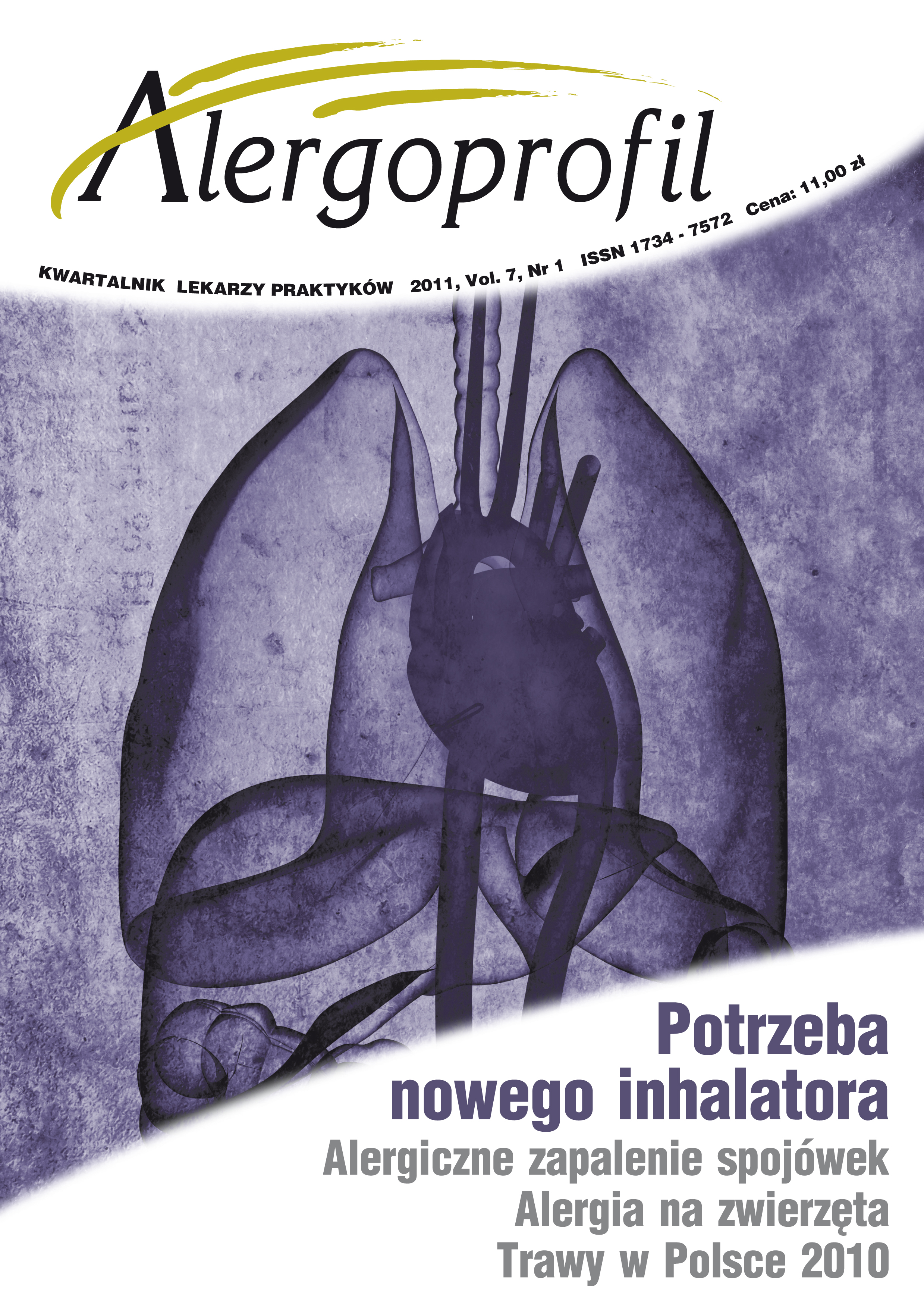Evaluation of expression of CD203c on the activated basophil surface in diagnosis of selected allergic disorders
Main Article Content
Abstract
Introduction: Increased incidence of the allergic-related diseases shows the significance of proper diagnosis. The methods being employed nowadays seem to be ineffective in some cases and considerably restricted. These procedures happen not to be practiced because they either do not comply with the requirements or there is danger of high risk life threatening anaphylactic reaction.
Objective: The aim of this research is estimate of expression CD203c in diagnosis of allergy to selected allergens: Dermatophagoides pteronyssinus, Dermatophagoides farinae, Timothy pollen and comparison these results with total and specific IgE tests.
Material and methods: The studies was carried out in a group 40 patients and in 29 healthy control. Skin prick test was performed with aeroallergens and total and specific IgE concentration was measured. To analyse basophils marked with the one anty-CD203c or cocktail of three antibodies (anty-CRTH2, anty-CD3 and anty-CD203c) the cytometric method has been used in this research. Results: Sensitivity of cytometric method was differentiated and depended on allergen (from 43.5% for Dermatophagoides pteronyssinus to 72.4% for Timothy pollen). Joined specific IgE with the cytometric method achieved findings enabled to increase the sensitivity to 78.3% for Dermatophagoides pteronyssinus and to 89.7% for Timothy pollen. In these assays specificity of cytometric method increases up to 100%.
Conclusions: Evaluation of CD203c expression is useful in aeroallergens allergy testing especially at person for whom another diagnostic methods do not comply with the requirements or there is danger of high risk life threating anaphylactic reaction.
Downloads
Article Details
Copyright: © Medical Education sp. z o.o. This is an Open Access article distributed under the terms of the Attribution-NonCommercial 4.0 International (CC BY-NC 4.0). License (https://creativecommons.org/licenses/by-nc/4.0/), allowing third parties to copy and redistribute the material in any medium or format and to remix, transform, and build upon the material, provided the original work is properly cited and states its license.
Address reprint requests to: Medical Education, Marcin Kuźma (marcin.kuzma@mededu.pl)
References
2. Bernstein I., Li J., Bernstein D. et al.: Allergy diagnostic testing: an updated practice parameter. Ann. Allergy Asthma Immunol. 2008, 100(Suppl. 3): 1-148.
3. Ebo D., Hagendorens M., Bridts C. et al.: Hymenoptera venom allergy: taking the sting out of difficult cases. J. Investig. Allergol. Clin. Immunol. 2007, 17: 357-360.
4. Ebo D., Sainte-Laudy J., Bridts C. et al.: Flow-assisted allergy diagnosis: current applications and future perspectives. Allergy 2006, 61: 1028-1039.
5. Sanz M., Sánchez G., Gamboa P. et al.: Allergen-induced basophil activation: CD63 cell expression detected by flow cytometry in patients allergic to Dermatophagoides pteronyssinus and Lolium perenne. Clin. Exp. Allergy. 2001, 31: 1007-1013.
6. Erdmann S., Sachs B., Kwiecien R. et al.: The basophil activation test in wasp venom allergy: sensitivity, specificity and monitoring specific immunotherapy. Allergy 2004, 59: 1102-1109.
7. Saporta M., Kamei S., Persi L. et al.: Basophil activation during pollen season in patients monosensitized to grass pollens. Allergy 2001, 56: 442-445.
8. Drug Hypersensitivity. Pichler W. (red.). Karger, Basel 2007.
9. Erdmann S., Heussen N., Moll-Slodowy S. et al.: CD63 expression on basophils as a tool for the diagnosis of pollenassociated food allergy: sensitivity and specificity. Clin. Exp. Allergy 2003, 33: 607-614.
10. Monneret G., Boumiza R., Gravel S. et al.: Effects of prostaglandin D(2) and 5-lipoxygenase products on the expression of CD203c and CD11b by basophils. J. Pharmacol. Exp. Ther. 2005, 312(2): 627-634.
11. Hauswirth A., Natter S., Ghannadan M. et al.: Recombinant allergens promote expression of CD203c on basophils in sensitized individuals. J. Allergy Clin. Immunol. 2002, 110: 102-109.
12. Saito H., Tsukidate T., Nakajima T. et al.: Gene expression profiles of human mast cells and basophils. Clin. Exp. Allergy 2006; 6: 85-90.
13. Kahlert H., Cromwell O., Fiebig H.: Measurement of basophil-activating capacity of grass pollen allergens, allergoids and hypoallergenic recombinant derivatives by flow cytometry using anti-CD203c. Clin. Exp. Allergy 2003, 33: 1266-1272.
14. Boumiza R., Debard A., Monneret G.: The basophil activation test by flow cytometry: recent developments in clinical studies, standardization and emerging perspectives. Clin. Mol. Allergy 2005, 30: 3-9.
15. González-Muńoz M., Villota J., Moneo I.: Analysis of basophil activation by flow cytometry in pediatric house dust mite allergy. Pediatr. Allergy Immunol. 2008, 19: 342-347.
16. Hennersdorf F., Florian S., Jakob A. et al.: Identification of CD13, CD107a, and CD164 as novel basophil-activation markers and dissection of two response patterns in time kinetics of IgE-dependent upregulation. Cell. Res. 2005, 15: 325-335.
17. Ebo D., Lechkar B., Schuerwegh A. et al.: Validation of a two-color flow cytometric assay detecting in vitro basophil activation for the diagnosis of IgE-mediated natural rubber latex allergy. Allergy 2002, 57: 706-712.
18. Bühring H., Streble A., Valent P.: The basophil-specific ectoenzyme E-NPP3 (CD203c) as a marker for cell activation and allergy diagnosis. Int. Arch. Allergy Immunol. 2004, 133(4): 317-329
19. Ocmant A., Peignois Y., Mulier S. et al.: Flow cytometry for basophil activation markers: the measurement of CD203c upregulation is as reliable as CD63 expression in the diagnosis of cat allergy. J. Immunol. Methods 2007, 320: 40-48.
20. Kleine-Tebbe J., Erdmann S., Knol E. et al.: Diagnostic tests based on human basophils: potentials, pitfalls and perspectives. Int. Arch. Allergy Immunol. 2006, 141: 79-90.
21. Yasnowsky K., Dreskin S., Efaw B. et al.: Chronic urticaria sera increase basophil CD203c expression. J. Allergy Clin. Immunol. 2006, 117: 1430-1434.

